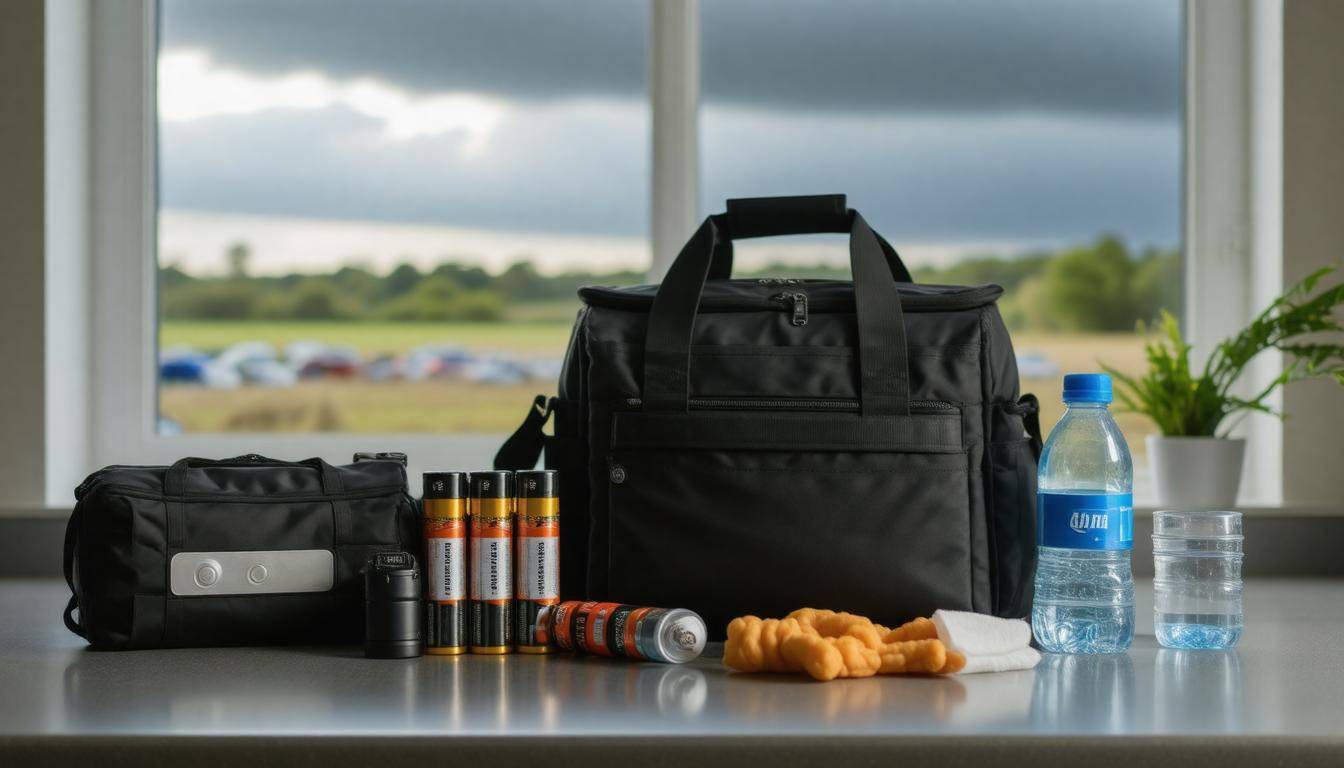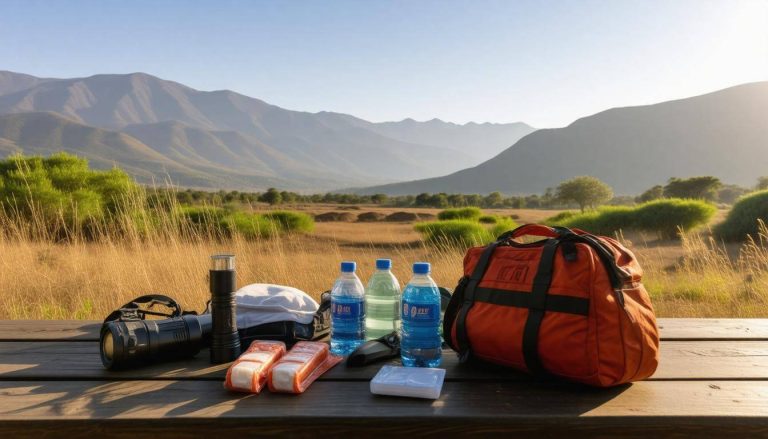When living in Western Australia, the looming threat of cyclones is just part of life. Whether you’ve experienced one before or it’s your first time preparing, knowing how to safeguard yourself and your family can make a world of difference. The key to weathering any storm lies in being proactive rather than reactive—understanding what supplies you need and how to organize them can save valuable time when every second counts. In this article, we’ll provide you with an easy-to-follow checklist filled with essential items for your cyclone kit. From food and water to communication tools and safety gear, let’s ensure you’re ready for whatever Mother Nature throws your way!
Your Cyclone Kit Checklist for Perth should include essential items such as water (at least 2 liters per person per day), non-perishable food, a first aid kit, flashlights with extra batteries, important documents, and a portable phone charger. Additionally, it’s critical to have a multi-tool, blankets or sleeping bags, a whistle for emergency signaling, and any necessary medications to ensure you and your family are well-prepared.

Perth Cyclone Preparedness Checklist
First and foremost, food and water are fundamental for any cyclone preparedness kit. When you’re facing a cyclone, being cut off from supplies is a real possibility. It’s crucial to store at least seven days’ worth of non-perishable food items. Think about items that require little to no preparation—canned goods such as vegetables, fruits, tuna or chicken, along with dried fruits, nuts, and energy bars to keep your spirits up during a stressful time.
Don’t forget that each person in your household should have at least 4 liters of water per day. In a situation where clean water might be scarce, planning accordingly becomes essential not just for hydration but also for cooking and hygiene.
Next comes the importance of staying connected.
Communication devices are paramount when preparing for a cyclone. A battery-powered or hand-crank radio should be one of the first things you pack into your kit. This will allow you to receive essential weather alerts even if the power goes out. You don’t want to find yourself in the dark amid chaos, disconnected from critical updates.
Additionally, consider including mobile phones with plenty of spare batteries or charged power banks to maintain communication lines with family members or emergency services. Modern technology assists here, but it’s advisable always to have a backup plan; after all, cyclones can disrupt entire networks.
Moving beyond food and communication, let’s talk about health essentials.
Now let’s talk about health: including a well-stocked first aid kit is an absolute must. This should encompass items like band-aids, antiseptics, pain relievers, and any prescription medications for those who may rely on them daily. It would be wise to check expiration dates regularly so that everything remains usable when needed.
Beyond basic medical supplies, having tools like scissors for cutting tape or gauze, tweezers for splinters or thorns, and a thermometer can make all the difference during an emergency when every second counts.
Being well-prepared doesn’t stop at these items; it also involves organization.
Having this checklist ensures that no crucial item is overlooked when time is of the essence. Storing your supplies in easily accessible containers labeled by category—for example, “Food,” “Water,” “Communication,” and “First Aid”—will allow everyone in your household to act swiftly under pressure. The stress of any natural disaster can cloud judgment; however, having organized resources can speed up response time and enhance safety measures significantly.
As we explore further into preparations, it’s essential to consider items that will keep you safe during a storm.
Essential Safety Items
Safety items are not just recommendations; they’re essentials that play a crucial role in maintaining your personal safety and the safety of your household during a cyclone. Among these necessities, flashlights and lanterns top the list. Imagine being caught in the dark with no electricity—this is where having multiple flashlights and battery-operated lanterns becomes invaluable. When the sun sets, visibility drops drastically, making it hard to navigate through your home or yard. Keep plenty of spare batteries on hand as well, because reliable lighting can help you assess damage, find emergency supplies, or even signal for help if needed.
Having adequate light sources is just one foundation of safety; protective gear is equally important.
Next on your essential list should be personal protective equipment. Sturdy gloves, goggles, and respiratory masks are vital in shielding you from potential hazards like flying debris and harmful dust particles kicked up by strong winds. The memory of Cyclone Ingrid in 2005 still resonates in Perth, where significant structural damage occurred. During such events, without proper protective gear, you expose yourself to risks that could easily be avoided. Taking precautions now can prevent injuries later, proving that preparation is not only smart but necessary.
- Flashlights: Ensure they are lightweight and easy to handle. Having multiple units throughout your home boosts accessibility.
- Battery-operated Lanterns: Opt for LED lanterns as they last longer and provide consistent light output.
- Sturdy Gloves: Look for durable material that offers both protection and dexterity.
- Goggles: Choose a pair that provides adequate ventilation to prevent fogging during use.
- Respiratory Masks: Make sure they fit snugly for maximum protection against fine particles.
By combining these essential items, you can enhance your preparedness and reduce the inherent risks associated with cyclones. Proactive measures ensure that you are ready to tackle whatever challenges Mother Nature may bring next.
Securing Your Home
A cyclone can unleash a tremendous amount of wind and rain that can wreak havoc on your property. To safeguard against possible damage, it’s vital to deepen your preparedness by securing critical entry points.
Begin with the front door: ensure it has sturdy locks and consider installing a deadbolt for added security. It may seem like basic advice, but weak doors pose a significant risk during intense storms.
The potential for forced entry increases exponentially in extreme weather; this is where proper locking mechanisms become essential.
Reinforce Windows and Doors
Storm shutters are a wise investment, but you also have the option of using plywood or storm panels as temporary measures if necessary. Ensure any installation is robust; flimsy materials are no match for the strength of cyclone winds. When covering windows, use at least 2-inch screws to fasten plywood against the frame, as this strengthens security while keeping glass breakage at bay.
According to the Australian Government’s Disaster Recovery Guide, homes with secured windows suffered significantly less damage. You’ll find that an ounce of preparation truly equates to a pound of prevention. Consider reinforcing sliding glass doors as well—these can often be vulnerable spots when strong winds hit.
Clear Surrounding Areas
After securing entry points, it’s time to turn your attention outdoors. Start by removing any loose items within your yard that could become projectiles when strong winds hit; think garden tools, furniture, and even pots or planters. If you have larger items like barbeques or patio furniture that can’t be moved indoors, secure them together or firmly anchor them down.
Don’t forget about your trees! Maintain your yard by trimming back any overhanging branches that pose a risk of falling onto structures or fences. Regular maintenance will not only protect your home from potential hazards but also keep everything looking neat and tidy throughout the year.
While addressing these immediate concerns is crucial, ensuring you have the right supplies on hand can further enhance your readiness in facing adverse weather conditions.
Portable Emergency Supplies

Being mobile with emergency supplies can be critical if evacuation is necessary, especially during a cyclone when conditions can change rapidly. The goal is to ensure that you have everything you need to stay safe and connected, even if you’re forced to leave your home in a hurry. Think of it as assembling a survival kit that you can grab on the go.
Important Documents
Start with important documents—keeping copies of identification, insurance papers, and emergency contacts in a waterproof container is essential. It might seem like a small detail, but imagine needing to access your ID or policy number in the chaos of an evacuation. Having these documents protected from potential water damage lets you focus on staying safe without worrying about losing vital information.
In fact, you might want to create a digital backup too. Take photos and store them securely on cloud services or an encrypted USB drive, ensuring you can access them no matter where you are.
Portable Power Solutions
Next up is having reliable power solutions on hand. Carrying portable solar chargers or power banks can keep essential devices like mobile phones operational when regular power sources fail. This consideration gained more significance after recent cyclones left thousands without power for days. Staying connected during such situations can make all the difference—whether it’s keeping track of weather updates or reaching out to loved ones.
When selecting your power source, consider investing in high-capacity models that can charge multiple devices at once and are easy to carry. If possible, choose solar chargers designed for outdoor use, as they tend to be more robust and efficient in emergencies.
Beyond these essentials, it’s important to prepare additional items that address personal safety and comfort in unpredictable circumstances.
Clothing and Personal Items
When it comes to preparing for a cyclone, your clothing choices can significantly affect your comfort and well-being. It’s essential to choose items that will not only keep you dry but also provide warmth when necessary. Imagine facing high winds and heavy rains without the right gear, standing soaked and cold; it’s a situation you’d want to avoid. Start by packing weather-appropriate clothing, including waterproof jackets and sturdy boots that can withstand mud and debris. In Perth, temperatures can vary wildly even during a storm, so layering with thermal wear may be wise.
Each family member should ideally have enough changes of clothes for at least five days. This means packing outfits that are easy to put on and remove, and don’t forget about undergarments. Comfort in wearing something clean can make a significant difference in morale.
Hygiene Kits
Alongside clothing, personal hygiene plays a vital role in your health during a cyclone. Just as you’d bring water and food supplies, don’t overlook the need for proper hygiene kits. These kits should include essentials such as toothbrushes, sanitary wipes, hand sanitizer, and portable toilets if you anticipate power or water loss. A clean environment helps prevent infections or illnesses during stressful times.
After Cyclone Seroja hit Perth, there was an overwhelming demand for hygiene items among those affected. Many were left without access to basic facilities, highlighting the importance of being prepared with these supplies ahead of time. You might think this is just common sense, but having these kits ready can save you from unnecessary inconvenience during an already challenging situation.
The key takeaway is to prioritize both clothing and hygiene essentials; they are not just survival items but critical components of maintaining your family’s comfort and health while facing unpredictable weather conditions.
As you continue preparing your checklist, focusing on these fundamental aspects will set the stage for further considerations regarding safety and structural integrity amid severe weather.
Weatherproofing and Shelter
Protecting your home from severe weather impacts is essential for ensuring safety. A crucial first step in weatherproofing is conducting a thorough roof inspection and making necessary repairs. Regularly examine the roof for any leaks or weakened spots, as even minor damages can worsen with intense winds and heavy rain.
Roof tiles should be securely fastened; loose ones can become dangerous projectiles that pose a threat not only to your property but also to people nearby. Taking the time to assess your roof’s condition can save you significant headaches later on.
Safety does not solely rely on the quality of your roof; designating a safe room is equally important. It’s beneficial to identify the sturdiest part of your home, preferably a small, windowless room, that can serve as an effective sanctuary during a cyclone. This could be an interior bathroom or pantry—areas that can withstand strong winds better than others.
For example, during Cyclone George, many Perth residents found their interior bathrooms served effectively as safe rooms—compact spaces shielded from windows and outside debris.
As you work on these aspects, it’s equally important to think beyond immediate protection and consider long-term solutions.
Along with your safe room, consider reinforcing doors and windows throughout your house. Adding storm shutters or plywood over windows can prevent breakage from flying debris, which is especially crucial during extreme weather conditions. Rainwater often accompanies cyclone events, so ensure that any drainage systems around your home are clear and functioning properly to avoid flooding.
Additionally, don’t overlook outdoor structures such as fences and sheds. They should be properly anchored or secured, minimizing the chance of them being damaged or becoming dangerous projectiles in high winds.
Lastly, maintain an emergency kit stocked with essentials like water, non-perishable food items, medical supplies, flashlights, and batteries in your designated safe room. Having these supplies at hand enables you and your family to stay safe and comfortable while waiting out the storm.
With your home’s safety measures in place, it’s time to turn our attention toward ensuring you’re ready for possible service interruptions that may arise during severe weather events.
Preparing for Power Outages

When the winds start to howl and the storm approaches, your thoughts should shift towards ensuring that you and your family are ready for any disruptions. Power outages can leave you in the dark—both literally and figuratively—if you aren’t prepared.
It’s essential to consider what supplies you’ll need to make your home comfortable during these uncertain times. One of the primary items is flashlights. They not only illuminate your paths but also provide safety during chaotic moments. Keep them in easily accessible places, such as near your main exit or on your bedside table. Having extra batteries is crucial too; there’s nothing worse than reaching for a flashlight only to find it dead when you urgently need it.
Power banks are another must-have; they’ll keep your essential devices running, allowing you to stay informed through weather updates or keep in touch with loved ones. While solar chargers might be less practical during storms, it’s smart to have a few power banks charged ahead of time.
Cooking becomes a challenge when the electricity goes out, making a reliable camp stove an invaluable asset. It can help maintain some sense of normalcy by allowing you to prepare meals even when appliances are down. Consider cooking hearty meals before the storm hits—they can be enjoyed cold if necessary, cutting down on the need for extensive cooking under pressure.
Essential Supplies and Their Importance
| Item | Importance | Estimated Cost |
|---|---|---|
| Flashlights | Essential for nighttime safety | $20 |
| Power Banks | Keep devices charged | $30 |
| Camp Stove | Cooking without electricity | $50 |
| Candles | Extra light source | $10 |
| Manual Can Opener | Required for food access | $5 |
Don’t forget about non-perishable food items as well; stocking up on canned goods lets you enjoy meals without worrying about refrigeration. However, acquiring a manual can opener is critical—what good is canned food without a way to get into it? If you’re concerned about how long the power might be out, think about getting some bottled water as well. Staying hydrated is vital for both health and morale.
Understanding these essential supplies will ensure that you’re well-equipped when challenging times arise. With this foundation in place, let’s explore the next steps to enhance your preparedness strategy.
Final Cyclone Preparedness Steps
Step I – Notify and Update Contacts
Communication is vital during a cyclone, so you should inform family and friends about your emergency plans and where you will be during the storm. This includes sharing details about evacuation routes, safe gathering places, and resources such as emergency shelters. Regular updates can relieve anxiety, providing assistance if needed. Staying in touch ensures that everyone knows how to reach one another, especially if power outages disrupt typical communication methods.
Step II – Emergency Drills
It’s beneficial to conduct emergency drills with all household members to ensure everyone knows what to do and where to go during a cyclone. Just like schools and workplaces in cyclone-prone areas prepare for emergencies through drills, your home can benefit from the same level of readiness.
Assign roles—who collects emergency supplies, who looks after pets, and how you’ll work together to secure the house. Practicing these procedures can transform chaos into coordinated response.
Remember, familiarity breeds comfort. The more prepared you are through practice, the more confidently you will respond when faced with actual circumstances.
Step III – Secure Your Home
In addition to practicing where to go, securing your home is critical. Remove outdoor furniture or anything that strong winds could turn into projectiles. Check that windows are secured and shutters are ready to be put in place if required. If you live in a high-risk flooding area, consider elevating valuable items off the ground or relocating them entirely.
Each step may seem small on its own, but collectively, they create a robust safety net that can protect you and your family when nature’s fury strikes. Preparation minimizes panic and allows for better decision-making when every second counts.
By following these steps, you can enhance your preparedness for cyclones and significantly increase your family’s safety during severe weather events. Stay safe!











